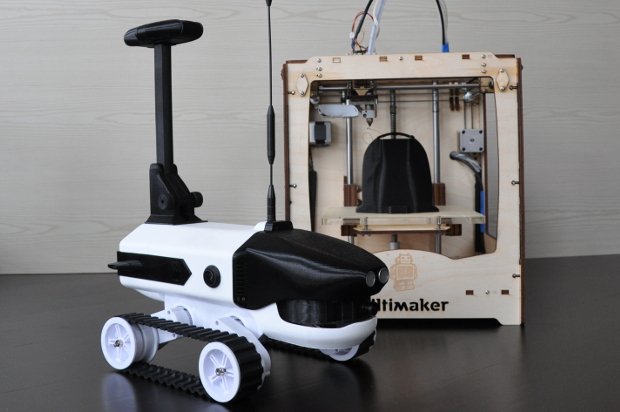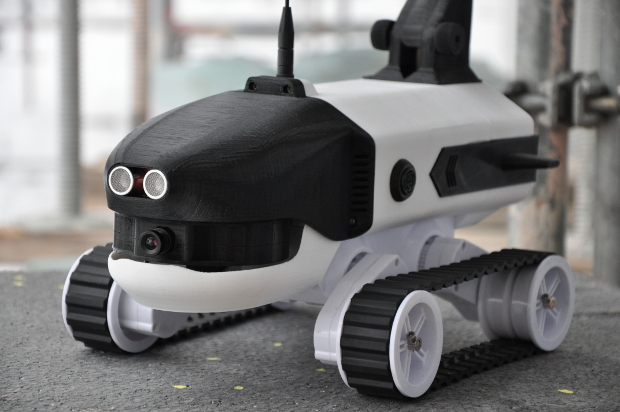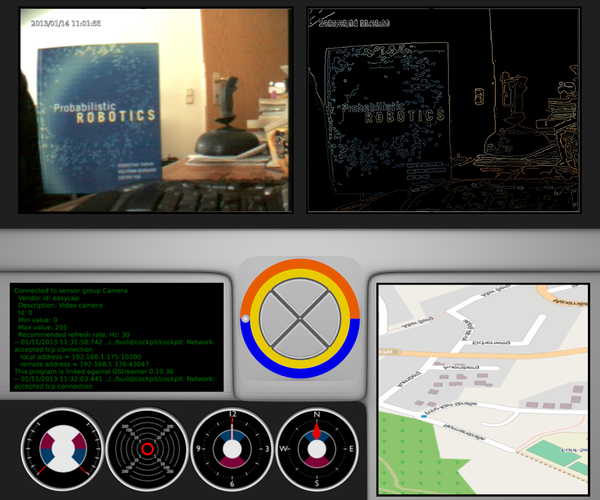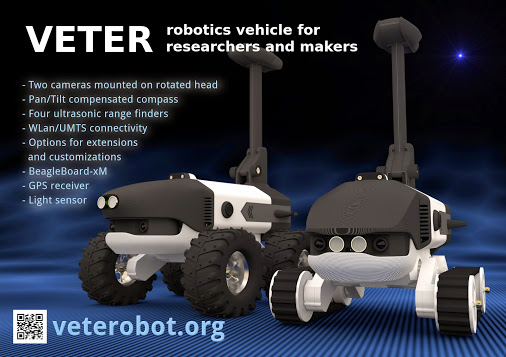Veter — robot for researchers and homebrew
Hello everyone!
So decided to write about your project and to listen to what people think about him. I don't have enough karma to write in DIY or Robotics, but perhaps later will suffer if they live to need karma
My two mates and I, as enthusiasts of 3D-printing, Linux and open source technologies made a small robot called "Wind" designed for experiments in navigation, control, computer vision and other typical problems in robotics.
Our main goal was to create a platform that would provide a basic set of functionality and was easily modifiable for the needs of specific projects. To achieve this goal, it was decided to use the technology of 3D printing for the casing. This makes it possible to easily integrate new sensors and actuators (for example, to install the Kinect sensor). The use of Linux and open hardware platform BeagleBoard-xM also opens up opportunities for modifications and extensions.

This is one of the variants of the robot (with one camera) on the background of our 3D-printer
The robot "Wind" is equipped with a wide range of sensors: two cameras mounted on a rotating platform, a digital compass with tilt compensation, four ultrasonic range finders, communication capability via WiFi or UMTS, GPS and auto light sensor. Using the BeagleBoard-xM as on-Board computer provides the computational power sufficient for adaptive video compression in real time in h264 format (using the integrated signal processor), the onboard control electronics and perform rather complex algorithms to navigate. At the same time, thanks to the efficiency of the ARM architecture, the robot can work 1.5-2 hours of offline power.

Implemented a set of software modules provides simple and convenient access to all installed sensors and actuators (motors) on the network. Because of this, the robot can be controlled remotely in manual mode, fully Autonomous (when starting the control program the on-Board computer), or through the Internet, receiving data from sensors in real-time (Cloud Robotics). For manual operation via the Internet implemented a program displays data from onboard sensors, including the video stream from the cameras. An interesting feature of the project is the use of Xenomai system which allows to achieve a much higher precision execution of the real-time programs running kernel Linux. In particular, the authors have implemented a Linux driver using Xenomai capabilities, enabling them to achieve high the quality of motor control. Also, the use of Xenomai has significantly simplified the electronics to operate the sensors and control the motors by transferring management functions to Linux.

Program for manual robot control
Also, we wrote set of examples that illustrate how to use the provided APIs for common tasks in robotics.

This is a poster made by designers for participation in exhibitions of all
We would like to note that in addition to programmers and electronics engineers, the project has attracted the attention of 3D designers who actively participated in the creation of 3D models alternative enclosure options. Examples can be view on the website Blender3D.ru.
As mentioned in the beginning, all models for 3D printing, circuits for electronics and software is available via the links given on the website of the project:veterobot.org.
Article based on information from habrahabr.ru
So decided to write about your project and to listen to what people think about him. I don't have enough karma to write in DIY or Robotics, but perhaps later will suffer if they live to need karma
My two mates and I, as enthusiasts of 3D-printing, Linux and open source technologies made a small robot called "Wind" designed for experiments in navigation, control, computer vision and other typical problems in robotics.
Our main goal was to create a platform that would provide a basic set of functionality and was easily modifiable for the needs of specific projects. To achieve this goal, it was decided to use the technology of 3D printing for the casing. This makes it possible to easily integrate new sensors and actuators (for example, to install the Kinect sensor). The use of Linux and open hardware platform BeagleBoard-xM also opens up opportunities for modifications and extensions.

This is one of the variants of the robot (with one camera) on the background of our 3D-printer
The robot "Wind" is equipped with a wide range of sensors: two cameras mounted on a rotating platform, a digital compass with tilt compensation, four ultrasonic range finders, communication capability via WiFi or UMTS, GPS and auto light sensor. Using the BeagleBoard-xM as on-Board computer provides the computational power sufficient for adaptive video compression in real time in h264 format (using the integrated signal processor), the onboard control electronics and perform rather complex algorithms to navigate. At the same time, thanks to the efficiency of the ARM architecture, the robot can work 1.5-2 hours of offline power.

Implemented a set of software modules provides simple and convenient access to all installed sensors and actuators (motors) on the network. Because of this, the robot can be controlled remotely in manual mode, fully Autonomous (when starting the control program the on-Board computer), or through the Internet, receiving data from sensors in real-time (Cloud Robotics). For manual operation via the Internet implemented a program displays data from onboard sensors, including the video stream from the cameras. An interesting feature of the project is the use of Xenomai system which allows to achieve a much higher precision execution of the real-time programs running kernel Linux. In particular, the authors have implemented a Linux driver using Xenomai capabilities, enabling them to achieve high the quality of motor control. Also, the use of Xenomai has significantly simplified the electronics to operate the sensors and control the motors by transferring management functions to Linux.

Program for manual robot control
Also, we wrote set of examples that illustrate how to use the provided APIs for common tasks in robotics.

This is a poster made by designers for participation in exhibitions of all
We would like to note that in addition to programmers and electronics engineers, the project has attracted the attention of 3D designers who actively participated in the creation of 3D models alternative enclosure options. Examples can be view on the website Blender3D.ru.
As mentioned in the beginning, all models for 3D printing, circuits for electronics and software is available via the links given on the website of the project:veterobot.org.
Комментарии
Отправить комментарий